Cetaceans are fully aquatic animals. This means that, except in exceptional circumstances, they spend their entire life in the water. Over time they have changed to better adapt to this aquatic life and although there is great diversity among the different species of cetaceans they all share certain characteristics which make them successful in their watery environment.
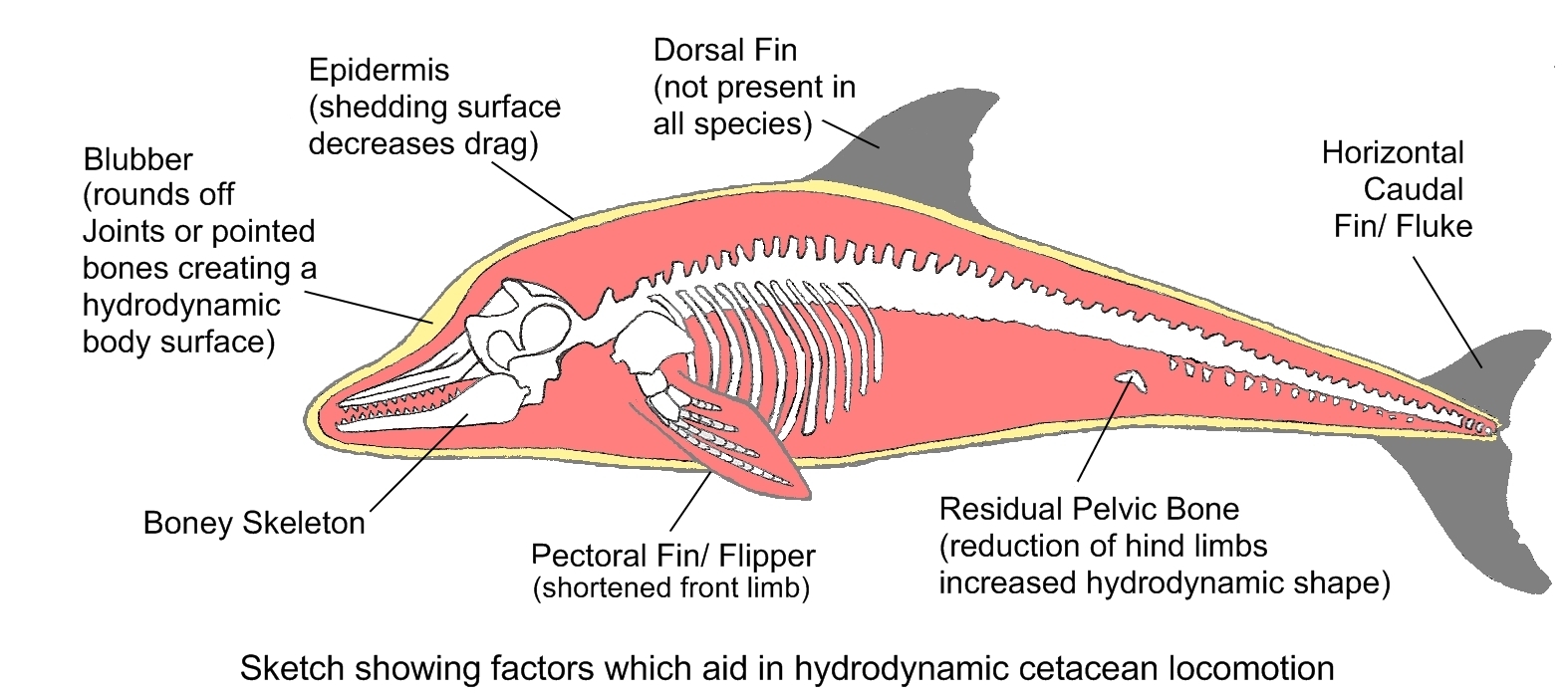
Locomotion
If you look at aquatic animals, their bodies tend to share certain characteristics which make them more efficient swimmers. The faster swimmers such as fish, seals, sea lions and cetaceans tend to have streamlined, hydrodynamic bodies which reduce the friction or drag of the water on their bodies enabling them to move more easily.
One of the first things you notice about the cetaceans is their streamlined body shape: they lack features which would hinder their movement through the water, such as pelvic/hind limbs, external ears, external reproductive organs and fur/hair (though some of them possess hair before birth or on their beaks as adults); their necks are short and stiff to enable swift swimming and their bodies are covered in specialized skin.The inner-most layer of this skin is a think layer of blubber (this is fat reinforced by elastic fibers and collagen) which covers angular, boney protrusions and ensures that the skin’s surface is streamlined. The outer skin layer also improves hydrodynamics by continually exuding oil droplets and shedding epithelial cells. The continual shedding of cells improves laminar flow by interrupting the formation of vortices and the oil helps to lubricate the skin allowing the water to pass over it more smoothly.
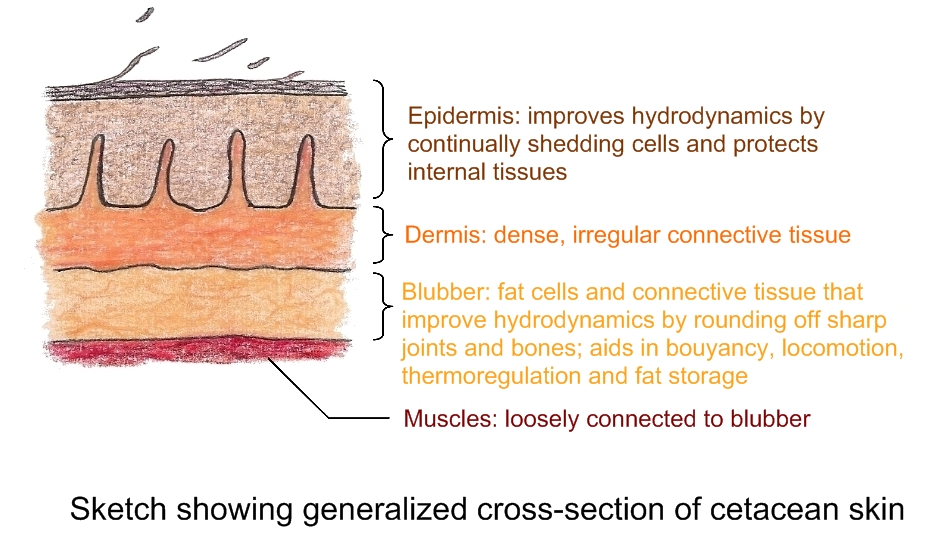 Cetaceans are excellent swimmers. They easily move thorough the water using a vertical motion of their powerful flukes (tail) to propel them forward while they guide themselves with their pectoral fins (flippers). Some have dorsal fins that scientists believe help to stabilize the animal by preventing them from rolling from side to side.
Cetaceans are excellent swimmers. They easily move thorough the water using a vertical motion of their powerful flukes (tail) to propel them forward while they guide themselves with their pectoral fins (flippers). Some have dorsal fins that scientists believe help to stabilize the animal by preventing them from rolling from side to side.
Research suggests that cetaceans are able to swim so swiftly and powerfully because of specialized connective tissue located in their blubber which works with the muscles to enable them to achieve powerful tail strokes. The tissue acts like a spring, so when the flukes are brought up, the tissue above it is compressed (like a spring) and as the tail starts moving downward the energy in the tissue is released and helps to push the tail downward. As the tail moves down, it compresses the tissue on that side which helps with the upward stroke.
Breathing
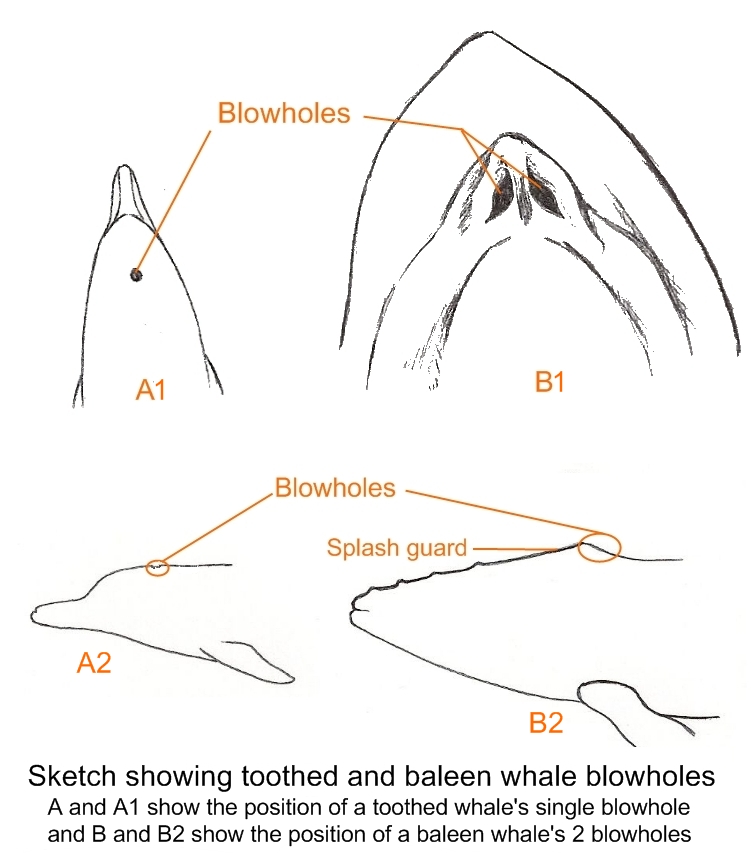 Unlike fish, cetaceans have lungs and although they spend the majority of their time underwater they still need to surface for air. Their nostrils (blowholes), are situated to the top of the head to allow them to breathe quickly and easily as they surface. As the animal surfaces it opens its blowhole(s) (toothed whales have a single blowhole, baleen whales have a pair), powerfully expels the air from its lungs, inhales quickly and closes the blowhole again to prevent water entering. The blowhole remains closed while the animal is underwater. All cetaceans are conscious breathers, which means that they do not breathe automatically like we do, they need to consciously choose to breathe. This is important as they often must hold their breaths for long periods of time while foraging.
Unlike fish, cetaceans have lungs and although they spend the majority of their time underwater they still need to surface for air. Their nostrils (blowholes), are situated to the top of the head to allow them to breathe quickly and easily as they surface. As the animal surfaces it opens its blowhole(s) (toothed whales have a single blowhole, baleen whales have a pair), powerfully expels the air from its lungs, inhales quickly and closes the blowhole again to prevent water entering. The blowhole remains closed while the animal is underwater. All cetaceans are conscious breathers, which means that they do not breathe automatically like we do, they need to consciously choose to breathe. This is important as they often must hold their breaths for long periods of time while foraging.
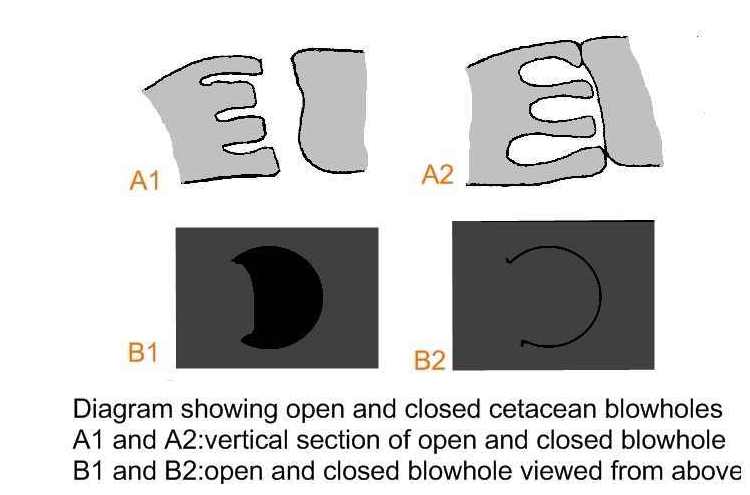 As cetaceans spend most of their time under the water, sometimes at great depths, they have developed special ways to improve their ability to store oxygen in their bodies whilediving. When a whale or dolphin takes a breath before diving, it does not inhale a particularly large amount of air. This is because it does not store most of the oxygen it needs for a dive in its lungs, but in its muscles and blood (in myoglobin and haemoglobin respectively). A cetacean has a lot of blood and muscle in which to store its oxygen and in addition it can reduce blood flow to non-essential tissues by slowing its heart rate and restricting blood access to those areas. In very long dives it can sometimes switch to anaerobic metabolism, which means for that period its body is functioning without oxygen.
As cetaceans spend most of their time under the water, sometimes at great depths, they have developed special ways to improve their ability to store oxygen in their bodies whilediving. When a whale or dolphin takes a breath before diving, it does not inhale a particularly large amount of air. This is because it does not store most of the oxygen it needs for a dive in its lungs, but in its muscles and blood (in myoglobin and haemoglobin respectively). A cetacean has a lot of blood and muscle in which to store its oxygen and in addition it can reduce blood flow to non-essential tissues by slowing its heart rate and restricting blood access to those areas. In very long dives it can sometimes switch to anaerobic metabolism, which means for that period its body is functioning without oxygen.
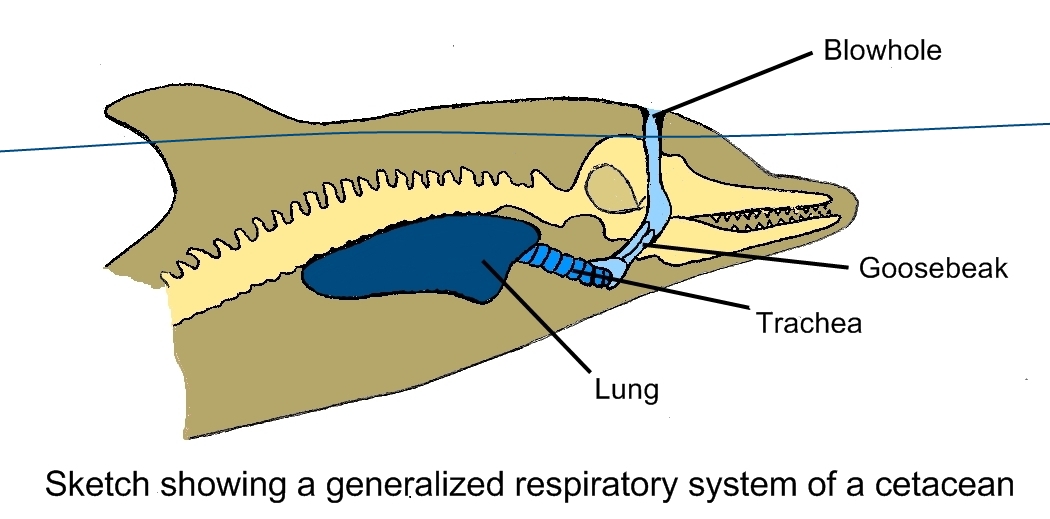 This ability to store oxygen in the blood and muscle rather than the lungs also allows cetaceans to to evade the danger of decompression sickness (‘the bends’) that human divers sometimes experience. Their diaphragm is positioned at an angle which allows the internal organs to press against the lungs, collaping them and squeezing any air into the trachea where no oxygen exchange can take place. In this way, excess nitrogen is not allowed to enter the blood and so cannot form the bubbles that cause ‘the bends’.
This ability to store oxygen in the blood and muscle rather than the lungs also allows cetaceans to to evade the danger of decompression sickness (‘the bends’) that human divers sometimes experience. Their diaphragm is positioned at an angle which allows the internal organs to press against the lungs, collaping them and squeezing any air into the trachea where no oxygen exchange can take place. In this way, excess nitrogen is not allowed to enter the blood and so cannot form the bubbles that cause ‘the bends’.
Maintaining Body Temperature
Water conducts heat about 25 times better than air. This means that aquatic animals, like cetaceans, will lose body heat 25 times faster than animals surrounded by air insead of water and so have a greater challenge keeping their bodies at the correct temperature. There are several adaptations that help them in thermoregulation (regulating their body temperature): their shape, blubber and a special circulatory system.
The roughly cylindrical shape of a cetacean's body has what is known as a low surface area to volume ratio which means is that it has a small surface area for its size and so a small surface from which to lose heat to the water. Its entire body (except for its dorsal fin, flukes and pectoral fins) is also covered with a thick layer of blubber to further reduce heat loss.
The areas which are not insulated by blubber, conserve heat by a special counter-current heat exchange system in which the veins coming from the skin (near the cold water) form a network around the arteries which are bringing warm blood from the heart. The arteries exchange heat with the veins allowing them to carry warm blood back to the heart thus keeping the core of the animal warm and reducing heat lose it to the external environment.
These measures to preserve heat work extremely well and in some conditions when the environment is very warm or the animal has exerted a lot of energy, making it hot, the cetacean needs to prevent itself from overheating. To do this it increases blood flow to the areas not insulated by blubber and allows blood to carry the heat to the surface where it dissipates into the environment.
Cetacean Senses
Cetaceans have similar senses to us: they can hear, see and feel but their sense of smell and taste is thought to be poor or non-existent in some. Hearing is their most well developed sense, which is not surprising as water conducts sound extremely efficiently (four times better than air). Although cetaceans have ear openings at the sides of their heads, it is not thought that the ear openings and ear canal play a great role in conducting sound to the ear; instead, sounds are conducted to the ear through the tissues at the side of the head and the fatty tissue in the lower jaw. Cetacean inner ears are located to the sides of the head suspended by ligaments just outside of the skull. This position helps the animals to determine sound direction underwater, something land mammals, including humans, are very poor at. Sound is important for communication, navigation and finding food.
Sight is also important to cetaceans but is sometimes poorly developed in some species that spend much of their time in poor visibility conditions. In good conditions sight will be used for navigation and sometimes prey-finding and visual communication. Interestingly cetaceans are able to adjust their eyes to have accurate vision both above and below the water due to elasticity of their eye lenses. They also have special glands that protect their eyes from the salt water.
Touch is especially important to cetaceans in a social context. Often dolphins are seen touching or petting each other to reaffirm social bonds. Although cetaceans have touch receptors all over the skin, they are most sensitive to touch in the head area around the blowhole(s). In addition, some baleen whales and riverine dolphins also make use of vibrissae (whiskers) possibly to tell the density of plankton or to move through obstacles in the river such as tree roots or fallen trees.


 Unlike fish, cetaceans have lungs and although they spend the majority of their time underwater they still need to surface for air. Their nostrils (blowholes), are situated to the top of the head to allow them to breathe quickly and easily as they surface. As the animal surfaces it opens its blowhole(s) (toothed whales have a single blowhole, baleen whales have a pair), powerfully expels the air from its lungs, inhales quickly and closes the blowhole again to prevent water entering. The blowhole remains closed while the animal is underwater. All cetaceans are conscious breathers, which means that they do not breathe automatically like we do, they need to consciously choose to breathe. This is important as they often must hold their breaths for long periods of time while foraging.
Unlike fish, cetaceans have lungs and although they spend the majority of their time underwater they still need to surface for air. Their nostrils (blowholes), are situated to the top of the head to allow them to breathe quickly and easily as they surface. As the animal surfaces it opens its blowhole(s) (toothed whales have a single blowhole, baleen whales have a pair), powerfully expels the air from its lungs, inhales quickly and closes the blowhole again to prevent water entering. The blowhole remains closed while the animal is underwater. All cetaceans are conscious breathers, which means that they do not breathe automatically like we do, they need to consciously choose to breathe. This is important as they often must hold their breaths for long periods of time while foraging.  As cetaceans spend most of their time under the water, sometimes at great depths, they have developed special ways to improve their ability to store oxygen in their bodies whilediving. When a whale or dolphin takes a breath before diving, it does not inhale a particularly large amount of air. This is because it does not store most of the oxygen it needs for a dive in its lungs, but in its muscles and blood (in myoglobin and haemoglobin respectively). A cetacean has a lot of blood and muscle in which to store its oxygen and in addition it can reduce blood flow to non-essential tissues by slowing its heart rate and restricting blood access to those areas. In very long dives it can sometimes switch to anaerobic metabolism, which means for that period its body is
As cetaceans spend most of their time under the water, sometimes at great depths, they have developed special ways to improve their ability to store oxygen in their bodies whilediving. When a whale or dolphin takes a breath before diving, it does not inhale a particularly large amount of air. This is because it does not store most of the oxygen it needs for a dive in its lungs, but in its muscles and blood (in myoglobin and haemoglobin respectively). A cetacean has a lot of blood and muscle in which to store its oxygen and in addition it can reduce blood flow to non-essential tissues by slowing its heart rate and restricting blood access to those areas. In very long dives it can sometimes switch to anaerobic metabolism, which means for that period its body is 